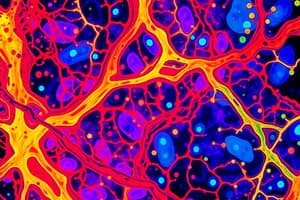Podcast
Questions and Answers
Pathology is the study of causes and effects of disease.
Pathology is the study of causes and effects of disease.
True (A)
All disturbances of function and structure in disease are due to cellular abnormalities.
All disturbances of function and structure in disease are due to cellular abnormalities.
True (A)
Cell death may occur due to lack of adaptation.
Cell death may occur due to lack of adaptation.
True (A)
Pathological stimuli cause cellular stresses.
Pathological stimuli cause cellular stresses.
The human body is made up of 1013 different cell types.
The human body is made up of 1013 different cell types.
Cellular pathology is only concerned with the study of abnormal cell growth.
Cellular pathology is only concerned with the study of abnormal cell growth.
Apoptosis is a tightly regulated process.
Apoptosis is a tightly regulated process.
Necrosis is an energy (ATP) dependent process.
Necrosis is an energy (ATP) dependent process.
Swelling and disintegration of organelles occur in apoptosis.
Swelling and disintegration of organelles occur in apoptosis.
Loss of plasma membrane integrity is a characteristic of necrosis.
Loss of plasma membrane integrity is a characteristic of necrosis.
Apoptosis results in the formation of membrane-bound vesicles.
Apoptosis results in the formation of membrane-bound vesicles.
Necrosis occurs at a temperature of 4°C.
Necrosis occurs at a temperature of 4°C.
Apoptosis is associated with a non-random degradation of DNA.
Apoptosis is associated with a non-random degradation of DNA.
Necrosis is associated with a ladder pattern on agarose gel electrophoresis.
Necrosis is associated with a ladder pattern on agarose gel electrophoresis.
During cell stress, adaptive responses include alterations in metabolism such as fatty acids mobilized from adipose tissue.
During cell stress, adaptive responses include alterations in metabolism such as fatty acids mobilized from adipose tissue.
Cell stress genes, such as heat shock proteins (HSPs), are essential for cell survival and have a high degree of evolutionary conservation.
Cell stress genes, such as heat shock proteins (HSPs), are essential for cell survival and have a high degree of evolutionary conservation.
Chronic stress can result in visible aggregates of constituents known as inclusion bodies.
Chronic stress can result in visible aggregates of constituents known as inclusion bodies.
Hyperplasia refers to an increase in the size of existing cells, matched by an increase in functional capacity.
Hyperplasia refers to an increase in the size of existing cells, matched by an increase in functional capacity.
Benign prostatic hyperplasia (BPH) is a risk factor for prostatic carcinoma.
Benign prostatic hyperplasia (BPH) is a risk factor for prostatic carcinoma.
Necrosis is triggered by acute stressors such as metabolic stress, hypoxia, and absence of nutrients.
Necrosis is triggered by acute stressors such as metabolic stress, hypoxia, and absence of nutrients.
Flashcards are hidden until you start studying




